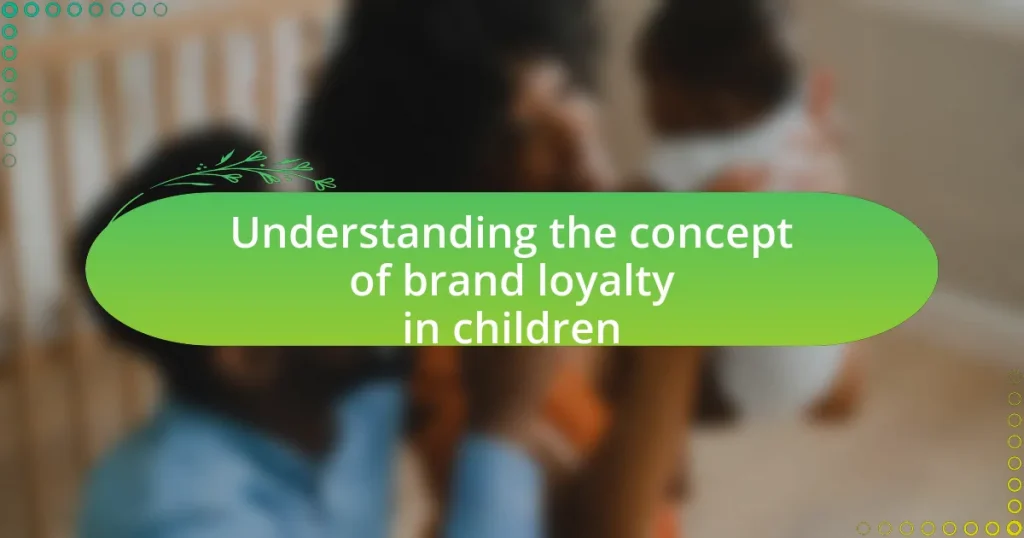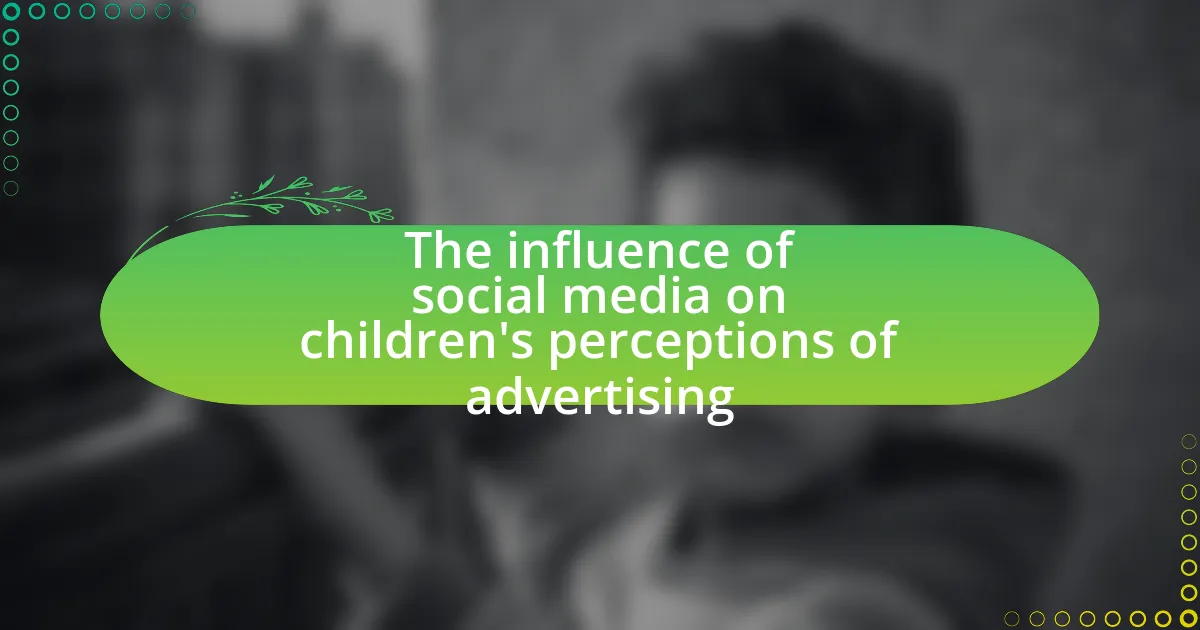Brand loyalty in children is defined as the consistent preference for specific brands influenced by emotional connections, familiarity, and peer interactions. This article explores the early onset of brand loyalty, beginning as young as age two, and examines the factors contributing to this phenomenon, including parental influence, marketing strategies, and social dynamics. It highlights the differences in brand loyalty between children and adults, the impact of brand loyalty on purchasing behavior and social interactions, and the ethical considerations marketers must address when targeting young consumers. Additionally, the article discusses effective strategies for brands to foster and maintain loyalty among children while adhering to responsible marketing practices.

What is brand loyalty in children?
Brand loyalty in children refers to the tendency of young consumers to consistently prefer and choose specific brands over others. This loyalty is often influenced by factors such as emotional connections, parental preferences, and marketing strategies that resonate with children. Research indicates that children as young as age 2 can exhibit brand loyalty, with studies showing that they can recognize and prefer brands based on familiarity and positive associations. For instance, a study published in the Journal of Consumer Research found that children develop brand preferences through repeated exposure and positive experiences, which solidifies their loyalty to certain brands as they grow older.
How is brand loyalty defined in the context of children?
Brand loyalty in the context of children is defined as a child’s consistent preference for a specific brand over others, influenced by emotional attachment, familiarity, and perceived quality. Research indicates that children develop brand loyalty as early as age two, with factors such as advertising, parental influence, and peer preferences playing significant roles in shaping their brand choices. For instance, a study published in the Journal of Consumer Research found that children are more likely to exhibit brand loyalty when they have positive experiences with a brand, reinforcing their attachment and preference over time.
What are the key characteristics of brand loyalty among children?
Key characteristics of brand loyalty among children include emotional attachment, familiarity, and peer influence. Children often develop strong emotional connections to brands that resonate with their interests and experiences, leading to a preference for those brands over others. Familiarity plays a crucial role, as repeated exposure to a brand through advertising and social interactions reinforces recognition and preference. Additionally, peer influence significantly impacts children’s brand choices, as they tend to favor brands that are popular among their friends and social circles. Research indicates that children as young as three can exhibit brand loyalty, demonstrating the early onset of these characteristics in their consumer behavior.
How does brand loyalty differ between children and adults?
Brand loyalty differs significantly between children and adults, primarily due to cognitive development and decision-making processes. Children often exhibit brand loyalty based on emotional connections, peer influence, and simplistic associations, such as colorful packaging or character endorsements. In contrast, adults typically base their loyalty on rational evaluations, including product quality, price, and personal experiences. Research indicates that children are more susceptible to marketing tactics, with studies showing that they can recognize brand logos as early as age two, while adults tend to engage in more critical analysis of brands, often influenced by reviews and brand reputation. This fundamental difference in how brand loyalty is formed highlights the varying psychological and social factors at play in different age groups.
Why is understanding brand loyalty in children important?
Understanding brand loyalty in children is important because it shapes their future consumer behavior and influences market trends. Children develop brand preferences early, which can lead to lifelong loyalty, impacting their purchasing decisions as adults. Research indicates that brand loyalty formed in childhood can result in a 20% increase in brand preference in adulthood, demonstrating the long-term effects of early brand attachment. This understanding helps marketers tailor strategies that resonate with young consumers, ultimately driving brand success.
What impact does brand loyalty have on children’s purchasing behavior?
Brand loyalty significantly influences children’s purchasing behavior by creating a preference for specific brands over others. Children who exhibit brand loyalty are more likely to request and choose products from their preferred brands, often leading to repeated purchases. Research indicates that children as young as age 2 can recognize and prefer brands, with studies showing that brand loyalty can lead to a 20% increase in sales for favored brands among young consumers. This loyalty is often cultivated through marketing strategies that resonate with children, such as engaging advertisements and brand mascots, which reinforce their emotional connection to the brand.
How does brand loyalty influence children’s social interactions?
Brand loyalty significantly influences children’s social interactions by shaping their preferences and peer relationships. Children who exhibit strong brand loyalty often align themselves with peers who share similar brand preferences, fostering a sense of belonging and identity within social groups. For instance, a study published in the Journal of Consumer Research found that children aged 8 to 12 are more likely to form friendships based on shared brand affiliations, which can enhance their social status among peers. This alignment can lead to group dynamics where brand loyalty becomes a social currency, impacting children’s interactions and acceptance within their social circles.

What factors contribute to brand loyalty in children?
Brand loyalty in children is primarily influenced by emotional connection, parental influence, and brand familiarity. Emotional connection arises when children identify with a brand’s values or characters, fostering attachment. Parental influence plays a significant role, as children often adopt brand preferences based on their parents’ choices and recommendations. Brand familiarity, developed through repeated exposure to advertisements and products, enhances recognition and preference. Research indicates that children as young as two can exhibit brand loyalty, with studies showing that familiar brands are preferred over unfamiliar ones, demonstrating the impact of these factors on their purchasing decisions.
How do emotional connections affect brand loyalty in children?
Emotional connections significantly enhance brand loyalty in children by fostering a sense of attachment and trust towards a brand. When children develop positive emotional experiences associated with a brand, such as joy or excitement from using a product, they are more likely to prefer that brand over others. Research indicates that children who feel emotionally connected to a brand are 50% more likely to remain loyal to it as they grow older, as these emotional ties create lasting impressions that influence their purchasing decisions. This loyalty is often reinforced through repeated positive interactions, such as engaging advertisements or relatable brand characters, which further solidify their emotional bond.
What role do parents play in shaping children’s brand preferences?
Parents play a crucial role in shaping children’s brand preferences by influencing their exposure to and perceptions of various brands. Research indicates that children often model their preferences based on parental choices, as parents serve as primary socialization agents. For instance, a study published in the Journal of Consumer Research found that children are more likely to prefer brands that their parents express positive attitudes toward, demonstrating the impact of parental influence on brand loyalty development. Additionally, parents’ purchasing decisions and discussions about brands can significantly affect children’s attitudes, leading to a strong correlation between parental brand preferences and children’s eventual choices.
How does peer influence contribute to brand loyalty among children?
Peer influence significantly contributes to brand loyalty among children by shaping their preferences and purchasing behaviors through social interactions. When children observe their peers expressing enthusiasm for specific brands, they are more likely to develop a favorable attitude towards those brands, as social acceptance plays a crucial role in their decision-making process. Research indicates that children aged 8 to 12 are particularly susceptible to peer influence, with studies showing that 70% of children report being influenced by friends when choosing products. This social validation reinforces their loyalty to brands that are popular within their peer groups, creating a cycle where brand loyalty is perpetuated through ongoing social interactions.
What role does marketing play in developing brand loyalty in children?
Marketing plays a crucial role in developing brand loyalty in children by creating emotional connections and fostering familiarity with brands. Children are highly influenced by marketing strategies that utilize colorful visuals, engaging characters, and relatable narratives, which capture their attention and create positive associations. Research indicates that children as young as two can recognize brands, and by age eight, they often exhibit brand preferences, influenced by targeted advertising and promotional activities. For instance, a study published in the Journal of Consumer Research found that children exposed to brand mascots are more likely to develop a preference for those brands, demonstrating the effectiveness of marketing in shaping their loyalty.
What types of advertising are most effective for children?
Television advertising and digital marketing, particularly through social media platforms, are the most effective types of advertising for children. Research indicates that children are highly influenced by visual and auditory stimuli, making colorful and engaging television commercials particularly impactful. A study published in the Journal of Advertising Research found that children aged 6 to 12 are more likely to remember and prefer brands that they see advertised on television compared to other mediums. Additionally, digital marketing strategies that utilize interactive content, such as games and videos on platforms like YouTube, have shown to significantly enhance brand recall among children. This effectiveness is attributed to the interactive nature of digital content, which captures children’s attention and encourages engagement.
How do brands engage children through interactive experiences?
Brands engage children through interactive experiences by creating immersive environments that encourage participation and creativity. These experiences often include gamified elements, augmented reality, and hands-on activities that captivate children’s attention and foster emotional connections. For instance, brands like LEGO utilize interactive play zones where children can build and create, enhancing their engagement and loyalty. Research indicates that children are more likely to develop brand loyalty when they have positive, memorable interactions with a brand, as these experiences create lasting impressions and emotional ties.

What are the implications of brand loyalty in children for marketers?
Brand loyalty in children significantly impacts marketers by creating a long-term consumer base that can influence purchasing decisions throughout a child’s development. When children develop strong preferences for specific brands, they are more likely to remain loyal to those brands into adulthood, as studies indicate that brand preferences formed in childhood can persist for years. For instance, research published in the Journal of Consumer Research shows that children as young as two years old can recognize and prefer brands, which suggests that early brand loyalty can lead to sustained market share for companies targeting young consumers. This loyalty can also drive word-of-mouth marketing, as children often share their preferences with peers, further amplifying brand visibility and influence.
How can brands effectively target children to build loyalty?
Brands can effectively target children to build loyalty by creating engaging, age-appropriate content that resonates with their interests and values. Research indicates that children are influenced by brand familiarity and emotional connections, which can be fostered through interactive marketing strategies such as games, contests, and social media engagement. For instance, a study published in the Journal of Consumer Research found that children who participate in brand-related activities are more likely to develop positive attitudes toward those brands. Additionally, brands that align their messaging with children’s aspirations and social values, such as sustainability or inclusivity, can enhance loyalty by making children feel connected to a larger purpose.
What strategies can brands use to maintain loyalty among young consumers?
Brands can maintain loyalty among young consumers by leveraging social media engagement, personalized marketing, and sustainability initiatives. Social media platforms are crucial for reaching young audiences, as 90% of teens use social media, making it an effective channel for brands to interact and build relationships. Personalized marketing, such as targeted ads and tailored content, resonates with young consumers, as studies show that 80% of consumers are more likely to make a purchase when brands offer personalized experiences. Additionally, sustainability initiatives appeal to the values of younger generations; research indicates that 73% of millennials are willing to pay more for sustainable products, reinforcing brand loyalty through shared values.
How can brands adapt to changing preferences as children grow?
Brands can adapt to changing preferences as children grow by continuously researching and analyzing developmental stages and trends in children’s interests. For instance, brands can utilize focus groups and surveys to gather insights on what appeals to different age groups, allowing them to tailor products and marketing strategies accordingly. Research indicates that children’s preferences shift significantly between ages 5 to 12, with a growing inclination towards technology and social media influences. By staying attuned to these changes, brands can innovate their offerings, such as introducing interactive and educational products that resonate with older children, thereby maintaining brand loyalty as they transition through different phases of growth.
What ethical considerations should marketers keep in mind?
Marketers should prioritize honesty, transparency, and respect for children’s vulnerability when promoting products to young audiences. Ethical marketing practices involve avoiding misleading claims and ensuring that advertisements do not exploit children’s lack of experience or understanding. For instance, the American Psychological Association emphasizes that children are particularly susceptible to persuasive messages, which necessitates a higher standard of ethical responsibility from marketers. Additionally, marketers should consider the implications of promoting unhealthy products, as research indicates that exposure to such marketing can influence children’s dietary choices and contribute to obesity. Therefore, ethical considerations in marketing to children must include a commitment to promoting positive values and protecting their well-being.
How can brands ensure responsible marketing practices towards children?
Brands can ensure responsible marketing practices towards children by adhering to strict ethical guidelines that prioritize the well-being and development of young audiences. This includes avoiding misleading claims, ensuring that advertisements are age-appropriate, and promoting healthy lifestyles. For instance, the American Psychological Association emphasizes that marketing directed at children should not exploit their inexperience or credulity. Additionally, brands can implement transparency by clearly disclosing the intent of their marketing efforts and providing educational content that empowers children to make informed choices. Research shows that responsible marketing not only fosters trust but also enhances brand loyalty among young consumers, as they are more likely to support brands that demonstrate social responsibility.
What regulations exist to protect children from manipulative marketing?
Regulations that protect children from manipulative marketing include the Children’s Online Privacy Protection Act (COPPA) in the United States, which restricts the collection of personal information from children under 13 without parental consent. Additionally, the Federal Trade Commission (FTC) enforces guidelines that prohibit deceptive advertising practices aimed at children. In the European Union, the Audiovisual Media Services Directive (AVMSD) sets strict rules on advertising to minors, including limitations on the types of products that can be marketed to children and the timing of such advertisements. These regulations are designed to safeguard children from exploitative marketing tactics that can influence their purchasing decisions and brand loyalty.
What are some best practices for fostering brand loyalty in children?
To foster brand loyalty in children, companies should engage them through interactive experiences and relatable messaging. Engaging children with interactive content, such as games or apps, creates a memorable connection with the brand. Research indicates that children are more likely to develop brand loyalty when they feel a personal connection, which can be achieved through storytelling that resonates with their experiences. Additionally, brands that incorporate educational elements into their products or marketing strategies tend to build trust and loyalty, as parents appreciate the value added to their children’s development. A study by the American Psychological Association highlights that children exposed to consistent brand messaging across multiple platforms are more likely to exhibit brand loyalty, reinforcing the importance of a cohesive marketing strategy.






